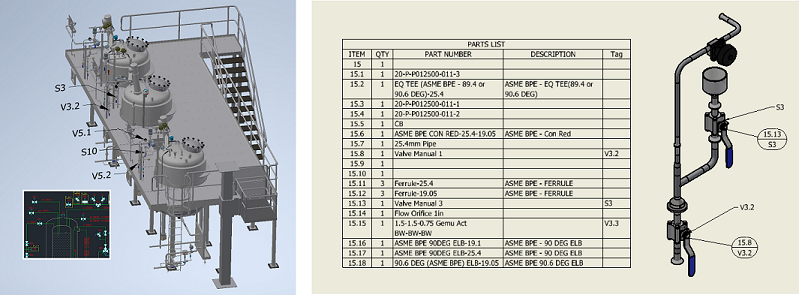Assigned properties to individual component instances that are stored in the parent assembly.
What's New: 2022
Each component has a set of standard iProperties which can be extended by adding custom iProperties. These properties are stored in the component file and are common to all instances of that specific component. Instance properties extend capabilities of custom iProperties. They are stored in the parent assembly file and let you assign properties to individual component instances. Unlike iProperties, instance properties don't affect the referenced component files.
Instance properties are available in annotations such as balloons, leader notes and parts lists. When you display component properties in annotations, instance property values have a higher priority than the values of custom iProperties. This means that when you use the same property name, the value of instance property overrides the value of custom iProperty. Like iProperties, instance properties are also accessible using API and iLogic.
Instance Properties
- Assign information (tags, properties) to individual component (part, assembly) instances.
- Are stored in the direct parent assembly.
- Stored in a subassembly are available in the top assembly.
- Can be viewed as extension of custom iProperties.
- Exist separately from custom iProperties or cover (override) custom iProperty values.
- Are created and edited in the Instance Properties or BOM dialog box.
- Can be included in parts lists, balloons, leader notes, and sketched symbols.
Use Instance Properties to:
- Override custom iProperty values for library (Content Center) components.
- Add tags from schematic diagrams to components in 3D model and use them in documentation.
- Identify location of individual components in transport boxes or in the installation.
- Separate individual instances in the BOM and parts list and add specific information to them, like component settings, possible component replacement, and more.
- Add custom IDs to individual components or component instances and use them to replace Item numbers in assembly and subassembly drawings.
- Add assembling information to models. For example, assign step sequence numbers to individual assembly components, or add welding information to welded components.

Instance Properties commands in the component context menu
Instance Properties browser commands are available only in context of the parent assembly. Multi-selection of component instances is supported.
Instance Properties creates or edits instance properties for the selected component instance.
Delete Instance Properties deletes all instance properties from the selected instance.
Instance Properties dialog box

Displays, adds, edits and deletes instance properties.
Browser marks, tooltips, and search

- A tooltip shows instance properties assigned to the component instance.
- A dot mark next to the instance name marks instances with instance properties.
- Instance properties are supported in browser search.
BOM dialog box

Displays, adds, edits, or deletes instance properties.
- The icon field for an Instance property row has a cyan background.
- Instance property values are blue.
- Tooltip lists instance properties assigned to the instance.
- Use the context menu to work with instance properties.
- Model Data tab separates all instance property rows. Other tabs show or merge instance rows based on Merge Instance Rows option in the Part Number Row Merge Settings dialog box.
Instance properties in leader text, parts list, balloons, and sketched symbols
- 2D or 3D leader text
- Sketched symbols
- Parts lists
- Balloons